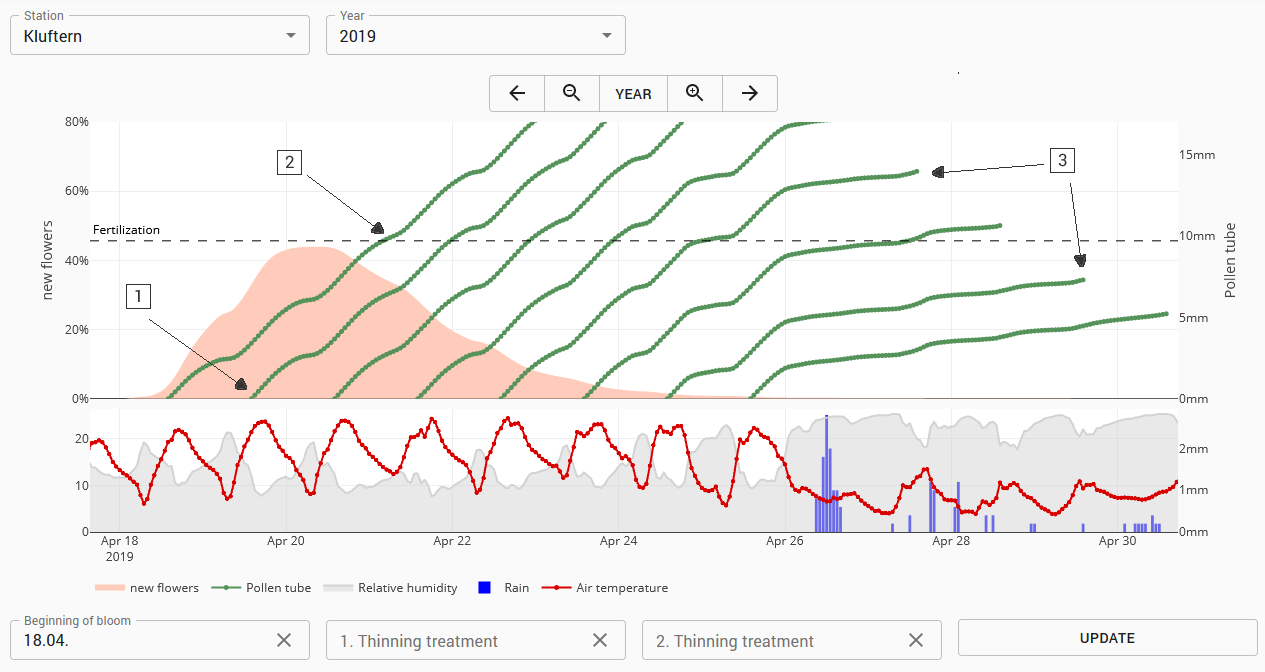fruitweb model Fertilization and Thinning
Fertilization in the apple
The fertilization of apple blossoms is a complex process that can be divided into the following stages:
-
- Pollination: Pollen of another variety usually gets onto the stigma of the flower through an insect.
- Fertilization in three steps:
- Depending on the humidity in the air, the pollen grains swell quickly on the moist surface of the stigma and begin to germinate.
- The pollen tubes grow through the stylus to the ovule (this is where the model starts.)
- The pollen fuse with the egg cell there
Successful fertilization depends on various factors
- flower visiting insects in the orchard
- Suitability of the pollen of the pollinating variety (apples are dependent on non-varietal pollen)
- Length of the stylus: this varies between 7 and 11mm depending on the variety. The longer the stylus, the longer a pollen tube needs to get to the egg cell
- Temperature: both the activity of pollinating insects and the growth of pollen tubes are highly temperature-dependent
Modeling of pollen tube growth

Research at Virginia Tech University in the USA has shown that the stylus of different apple varieties is on average 9.7mm long. The rate of growth of the pollen tube has been determined in the laboratory at various temperatures, so that a temperature / rate of growth table can be used to determine when the flower will be fertilized. With this information, a model can be developed that is suitable for assessing the quality of the fertilization of an apple variety.
The fruitweb fertilization model assumes that pollen grains get onto the stigma of freshly opened flowers every day at 12 noon. The pollen tube growth begins (green line) [1]. If the pollen tube reaches the average stylus length of 9.7mm, it can be assumed that these flowers have been fertilized successfully [2].
Flowers age and fertilization usually takes place in the first few days. If the temperature in the flower is too low, not all of the flowers will be fertilized. The model assumes that an egg cell in the flower is either fertilized within 5 days or dies. For this reason, the curve is terminated in the simulation after 5 days [3].
Thinning with agents that corrode the flower organs

The above method for estimating the fertilization situation makes it possible to determine the most favorable treatment dates when thinning with caustic preparations. Ideally, the model can be used to determine when the royal flowers were fertilized. If treatment is carried out after this point in time, the fruit set will be disturbed in all flowers that have not yet been fully fertilized. This is indicated in the model by resetting the green lines [4]. Flowers that open and pollinate after treatment can be re-fertilized. In order to prevent fruit set, a new treatment would have to be carried out before the pollen tube reaches the fertilization line [5].
Consideration of other factors
Variety-specific differences are not yet taken into account in the model. Unfortunately, at the moment there is no information about the stylus length of the apple varieties currently used in Central Europe.
In addition, the pollination situation is heavily dependent on the local conditions (pollinator varieties, pollinating insects). Another point is the relative humidity. If this becomes too low during the pollination process, the germination of the pollen can be impaired.
When deciding on how to regulate the crop load, these factors must therefore be taken into account.
Literature
Candace N. DeLong , Keith S. Yoder, Leon Combs , Richard E. Veilleux, and Gregory M. Peck. (2016). Apple Pollen Tube Growth Rates Are Regulated by Parentage and Environment. Journal of the American Society for Horticultural Science. 141(6):548–554
Khalil R. Jahed1and Peter M. Hirst. (2017). Pollen Tube Growth and Fruit Set in Apple. HORTSCIENCE 52(8):1054–1059
Yoder, K. S., Peck, G. M., Combs, L. D., Byers, R. E., & Smith, A. H. (2013). Using a pollen tube growth model to improve apple bloom thinning for organic production. In Acta Horticulturae. https://doi.org/10.17660/ActaHortic.2013.1001.23
